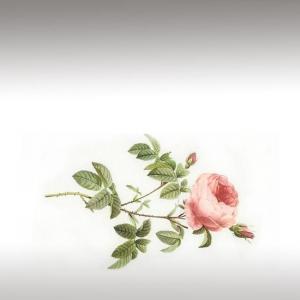
TEA ROSE ESSENTIAL OIL (ROSA ODORATA) - ESSENTIAL OILS

BASE / GENERAL DATA
Information submited: March 12, 2014 Modified: March 7, 2018 By: OperaDreamhouse
Botanical Name: Rosa odorata
Common Method of Extraction: Solvent Extracted Absolute
Part Typically Used: Flowers
Color: Pale golden
Consistency: Thin
Perfumery Note: Middle
Strength of Initial Aroma: Soft, green, ambery, roseaceous bouquet with a delicate warm pungent, spicy undertone.
Rosa odorata cultivated in China and introduced to Europe in the 1800s, having fragrant tea-scented yellowish or pink flowers.
The name 'Tea rose' is the result of a misunderstanding - the rose was created in the Fa Tee nursery near Canton in China. In 1810 it was discovered by an Englishman who sent a specimen to England. It is the ancestor behind several yellow and yellowish modern roses.
However, the scent of these roses is rather different from that of traditional roses. Surprisingly, their scent is strongly influenced by the aromatic compound orcinyl dimethyl ether, or 3,5-dimethoxy-toluene, which is chemically related to the oakmoss odorants. This phenol ether has a warm and sweet, nut-like, earthy-mossy odour - according to Arctander.
Immediately upon their introduction in the early 19th-century breeders went to work with them, especially in France, crossing them first with China roses and then with Bourbons and Noisettes. The Tea roses are repeat-flowering roses, named for their fragrance being reminiscent of Chinese Black Tea (although this is not always the case).
The colour range includes pastel shades of white, pink and (a novelty at the time) yellow to apricot. The individual flowers of many cultivars are semi-pendent and nodding, due to weak flower stalks. In a "typical" Tea, pointed buds produce high-centred blooms which unfurl in a spiral fashion, and the petals tend to roll back at the edges, producing a petal with a pointed tip. The Teas are thus the originators of today is "classic" florists" rose form.
According to rose historian Brent Dickerson, the Tea classification owes as much to marketing as to botany. 19th-century nurserymen would label their Asian-based cultivars as "Teas" if they possessed the desirable Tea flower form, and "Chinas" if they did not. Like the Chinas, the Teas are not hardy in colder climates.
Rose absolute oil has high levels of antioxidant, vitamin C, tocopherols, phenolics and beta carotenes.
Common Method of Extraction: Solvent Extracted Absolute
Part Typically Used: Flowers
Color: Pale golden
Consistency: Thin
Perfumery Note: Middle
Strength of Initial Aroma: Soft, green, ambery, roseaceous bouquet with a delicate warm pungent, spicy undertone.
Rosa odorata cultivated in China and introduced to Europe in the 1800s, having fragrant tea-scented yellowish or pink flowers.
The name 'Tea rose' is the result of a misunderstanding - the rose was created in the Fa Tee nursery near Canton in China. In 1810 it was discovered by an Englishman who sent a specimen to England. It is the ancestor behind several yellow and yellowish modern roses.
However, the scent of these roses is rather different from that of traditional roses. Surprisingly, their scent is strongly influenced by the aromatic compound orcinyl dimethyl ether, or 3,5-dimethoxy-toluene, which is chemically related to the oakmoss odorants. This phenol ether has a warm and sweet, nut-like, earthy-mossy odour - according to Arctander.
Immediately upon their introduction in the early 19th-century breeders went to work with them, especially in France, crossing them first with China roses and then with Bourbons and Noisettes. The Tea roses are repeat-flowering roses, named for their fragrance being reminiscent of Chinese Black Tea (although this is not always the case).
The colour range includes pastel shades of white, pink and (a novelty at the time) yellow to apricot. The individual flowers of many cultivars are semi-pendent and nodding, due to weak flower stalks. In a "typical" Tea, pointed buds produce high-centred blooms which unfurl in a spiral fashion, and the petals tend to roll back at the edges, producing a petal with a pointed tip. The Teas are thus the originators of today is "classic" florists" rose form.
According to rose historian Brent Dickerson, the Tea classification owes as much to marketing as to botany. 19th-century nurserymen would label their Asian-based cultivars as "Teas" if they possessed the desirable Tea flower form, and "Chinas" if they did not. Like the Chinas, the Teas are not hardy in colder climates.
Rose absolute oil has high levels of antioxidant, vitamin C, tocopherols, phenolics and beta carotenes.

SPIRITUAL PRACTISES DATA

MEDICINE / HEALTH DATA

BEAUTY / COSMETICS DATA

FOOD / COOKING DATA
COMMENTS
No comments.


